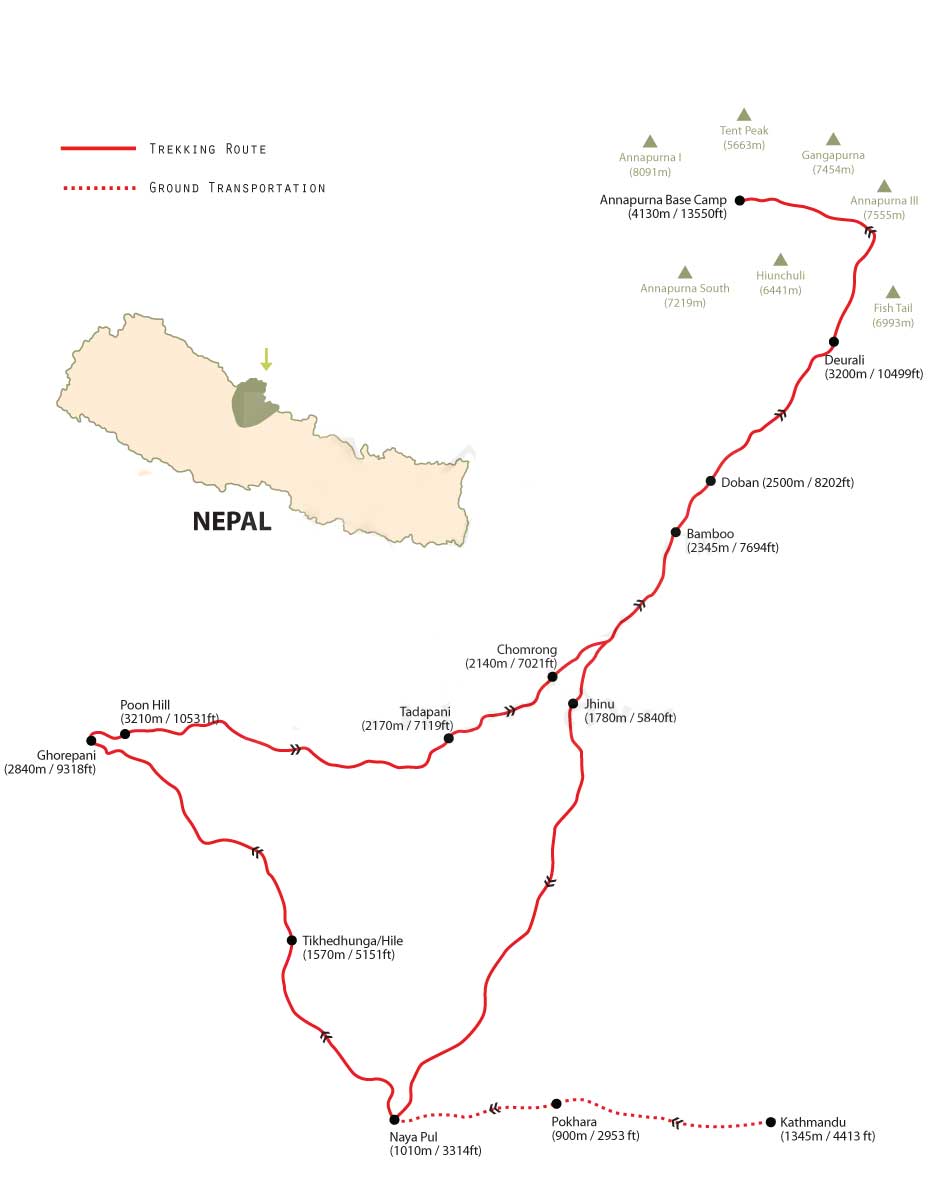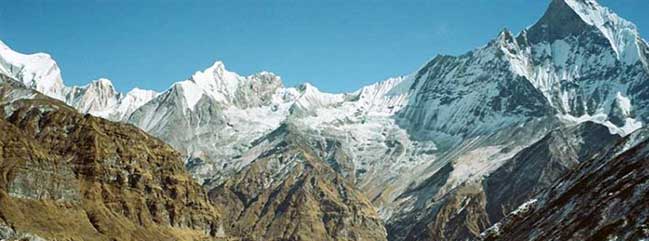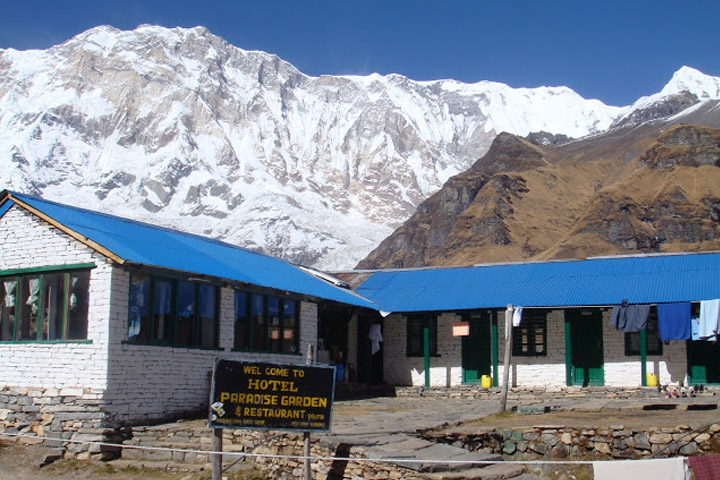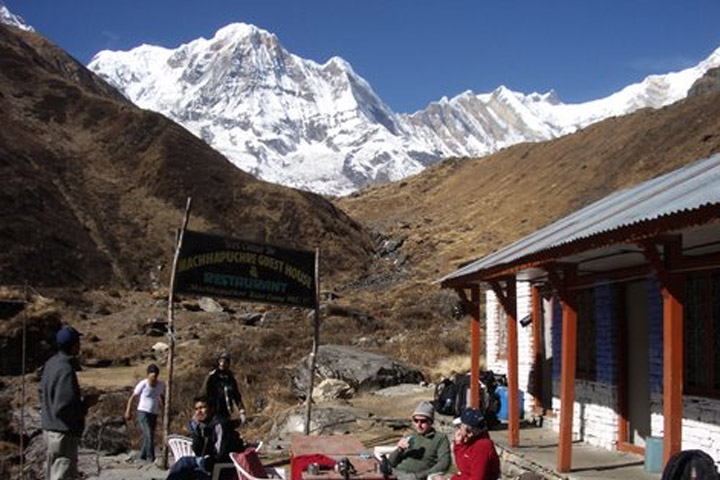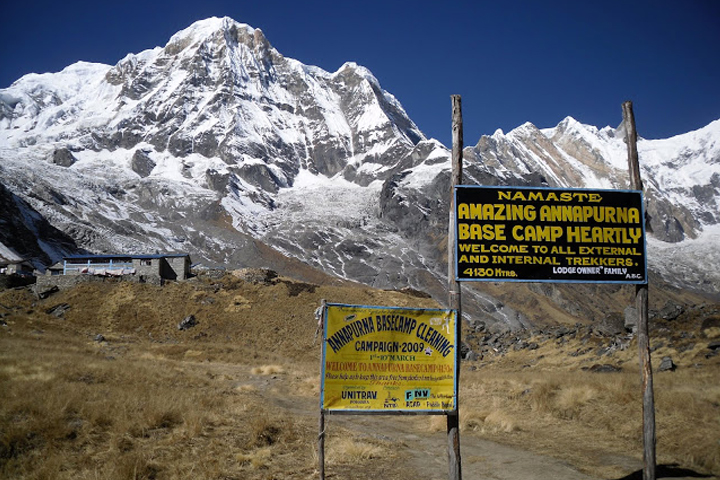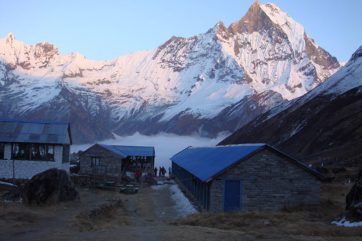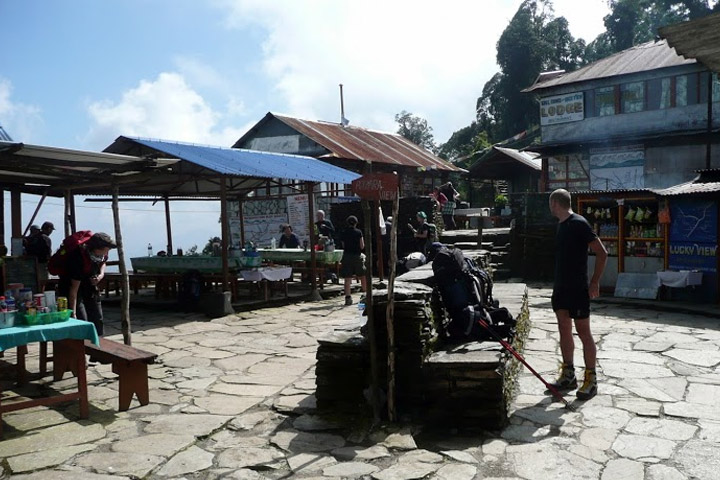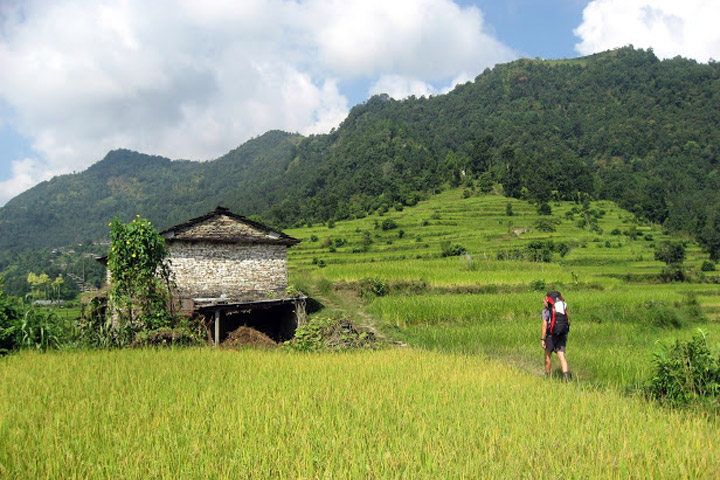Annapurna Base Camp Trek combines some of the most spectacular mountain scenery, providing a fascinating insight into the modern hill life of Nepal. This is unique trek along local trails, through forests, villages and terraced farmland treats you to unparalleled mountain scenery, surrounded by enormous glaciers giving you an inside experience into the Nepalese life and culture.
The trek to Annapurna base camp follows the Modi River and passes through dense stands of rhododendron and bamboo. By the time you reach the large rock over hanging, known as Hinku Cave, you will have noticed that the vegetation has thinned and the gorge narrowed to be only a few hundred meters wide. Steep snow-clad ridges falling from Hiunchuli on the left and Machhapuchhre on the right from the entrance to the Sanctuary. As we pass through the “gate” and enter to the Sanctuary, you find yourself in a huge amphitheatre enclosed by a solid wall of snow capped peaks.
This is one of the most beautiful treks that combine easy walking with majestic scenery and a mix of cultures unmatched by any other treks in Nepal. The trail starts from lowland villages and rice terraces deep into the Annapurna Himal. As you gradually climb uphill, the peaks of Annapurna south and Hiunchuli emerge from behind the foothills. Pastures and cultivated fields soon give way to deep forests of oak, bamboo and rhododendron. The trail finally stumbles across moraines and reaches Annapurna Sanctuary from where you will see undeniably beautiful and unimaginable 360 degree views of the Annapurna mountain ranges.
Day 01- Arrival in Kathmandu airport (1345meters).
There you will be met by our Airport Representative and transferred to hotel by private tourist vehicle. Overnight at hotel.
Day 02- Pre-trip Meeting and Sightseeing around Kathmandu valley.
In the morning after breakfast at 9 AM, we host a Pre-Trip meeting at your hotel in Kathmandu and introduced your trek Leader/Guide mean time and it will provide an opportunity for individuals to ask questions about the your trek and to introduce you to other participants. This includes a final briefing and preparations for the trip.
PLEASE ADVISE US IF YOU WILL BE ARRIVING LATE AND ARE THEREFORE UNABLE TO ATTEND THE PRE-TRIP MEETING.
In THE PRE-TRIP MEETING All passengers MUST bring:
1. Passport.
2. Four copies of Passport size photos each.
3. Travel Insurance Policy.
4. A writing pen
5. Notepad.
After the Pre-Trip meeting and breakfast your sightseeing trip will start at 9.45 AM in the morning. We provide a private vehicle and professional tour guide. We visit Bodhnath Stupa, one of the biggest Buddhist shrines in the world, where we observe Buddhist monks in prayer in the monasteries surrounding the stupa. After Bodhnath Stupa we visit Pashupatinath, the most famous Hindu temple in the country, located on the banks of the holy Bagmati River. Here we see Hindu holy men (sadhus) meditating, pilgrims bathing and occasionally funeral pyres burning on the ghats. We also visit Bhaktapur Durbar Square, which is a collection of pagoda and shikhara – style temples grouped around a fifty-five-window palace of brick and wood. The attraction of the Bhaktapur Durbar Square is The Lion gate, The Golden gate, The Palace of fifty five windows, Art Galleries, The Statue of King Bhupatindra Malla.
The rest of our time in Kathmandu is free for further exploration and some last-minute shopping in Thamel area near by your hotel. Later, we are supplied with our Trek Pack and departure information for tomorrow. Overnight at hotel.
Day 03- Drive to Pokhara (900 meters) 7 hours by tourist bus.
Trekking staff will arrive at your Hotel at 6:30 am in the morning to pick you up then the bus will leave around 7.30 am to Pokhara. Pokhara is a beautiful valley, with panoramic views of Annapurna, Machapuchare (shape of fish tail) in the north, Dhaulagiri in the west, Lamjung Himal and Manaslu in the east. The town of Pokhara is set on the banks of the Phewa Lake. It is smaller and much less hectic than Kathmandu providing the perfect starting point for our trek. Overnight at hotel.
Day 04- Drive to Nayapul (1010meters) and trek to Tikhedunga (1570meters) 3 hours.
We begin our trek at Nayapul after 1 hour driving by private vehicle from Pokhara. After 15 minutes short walk along the banks of the Modi Khola, we reach Birethanti (1015meters) a large village that has many shops and teahouses. From there, the trail continues through the village. The trail follows the north bank of the Bhurungdi Khola. The trail climbs steadily up the side of the valley to Hille at 1495m and after the short climb, we reach Tikhedhunga at 1570meters. Today’s walk offers a short and relatively easy day, during the journey allowing to get use to the experience of trekking in Nepal. Overnight at guesthouse.
Day 05- Trek to Ghorepani (2840meters) 5 hours.
Leaving Tikhedunga, we begin our journey with a steep climb to Ulleri. Ulleri is a large Magar village at 2070meters. The trail then continues to ascend more gently, through fine forests of oak and rhododendrons towards Banthanti at 2250meters. Then we trek towards Nangethanti at 2460m. After an hour walk we arrive at Ghorepani at 2840meters. Overnight at guesthouse.
Day 06- Hike up to Poon Hill (3210meters) and trek to Tadapani (2610meters).
Today, very early in the morning, we start an hour hiking to Poon Hill at elevation of 3210meters, a brilliant spectacle; this vantage point provides an unobstructed view of sunrise over the high Himalayas. There we spend about 1 hour, then returning to Ghorepani we take a hot breakfast at hotel. Leaving Ghorepani, we make climb along ridges, and through pine and rhododendron forests to Deurali (2960meters). After that we descend to the Banthanti, then turning off to Tadapani. Overnight at guesthouse.
Day 07- Trek to Chommrong (2140meters.) 5 hours.
The day starts with steep downhill through rhododendron forests. Leaving Tadapani, we descend steeply through forests and then the trail eases as we reach Gurjung which is the village of Gurung people, with an easy walk to Chommrong at elevation of 2140 meters. Overnight at guesthouse.
Day 08- Trek to Dovan (2500meters) 5.30 hours.
Today the trail drops down to the Chhomrong Khola and again we continue climbing to Khuldighar at 2380meters where there used to be an ACAP (Annapurna Conservation Area) Check post. There is a clearing in the forest a little further on, from which, the route travels very steeply down a rock bank then levels out, running through thickets of bamboo at the bottom of the gorge, keeping always on the west side of the river. Overnight at guesthouse.
Day 09- Trek to Deurali (3200meters) 4 hours.
A short walking day today because of altitude and risk of snow avalanches in the area that we need to cross in the next morning. Our day begins with the climb through bamboo, then rhododendron forests to Himalayan Hotel and on to Hinko cave. The accommodation will be in Deurali, on the ridge above Hinko is the stretch of trail that is most subject to avalanche. Overnight at guesthouse.
Day 10- Trek to Annapurna Base Camp (4130meters) 5 hours.
Today the trail climbs on past the Machhapuchhare Base Camp, which isn’t really a base camp since climbing the mountain is not permitted. Since it is totally surrounded by mountains, this area is known as the Annapurna Sanctuary. Two hours trek from Machhapuchhare Base Camp takes you to the Annapurna Base Camp (ABC) at elevation of 4130 meters. There, you will view unobstructed views of mountain scenery, which is very spectacular. Overnight at guesthouse.
Day 11- Trek back to Bamboo (2345meters) 6 hours.
We follow the same trail down today the trail drops down by 1700 meters to the bank of Modi Khola to Bamboo at 2345meters where there are few teahouse/lodges available to stay at. Overnight at guesthouse.
Day 12- Trek to Jhinu hot spring (1780meters) 5 hours.
We follow the same trail until Chommrong. Once we have passed Khuldighar there is an experimental sheep farm, the trail continues through rhododendron and bamboo fields. From Chomrong the trail descending very steeply to the Jhinu hot spring, where you can bathe in natural hot springs. Overnight at guesthouse.
Day 13- Trek to Nayapul (1010 meters) and drive to Pokhara.
From Jhinu hot spring we walk at the right side of Modi Khola for 4.30 hours to Birethanti which is consider one of the best and relaxing walk of the entire trek. We reach Nayapul then an hour drive will take us back to Pokhara. Overnight at hotel.
Day 14- Pokhara City tour.
Your sightseeing trip will start at 9 AM in the morning after breakfast. Places we visit are Fewa Lake, Bagnes Lake, Devi’s water fall, Museum, Tibetan refugee settlement and Gupteshower cave. You will have relaxing afternoon. Overnight at hotel.
Day 15- Drive back to Kathmandu (1345meters).
Overnight at the hotel in Kathmandu. If you are interested in continuing onto Chitwan Jungle Safari, River Rafting Adventure, Kathmandu Shopping Tour or Scenic Everest Flight.
Day 16- Transfer to international airport for your final departure.
The trip ends, our Airport Representative will drop you to the Kathmandu International Airport for your flight departure from Nepal.
Note: The above information is a guide and standard template of what we provide. The trek can be customized at your request to accommodate your specific requirements.
Note : On adventure trips of this type, weather, local politics, transport or a multitude of other factors beyond our control can result in a change of itinerary. It is, however, very unlikely that the itinerary would be substantially altered; if alterations are necessary the leader will decide what is the best alternative, taking into consideration the best interests of the whole group. Where a change does occur, we do everything we can to minimize its effect, but we cannot be responsible for the results of changes or delays.
Q.What type of shape do I need to be in, is this trip for me?
A. Trekking is suitable for average people who are moderately fit, thus no previous experience is required. Some physical fitness programs such as running, swimming, hiking is recommended before you embark on your journey. Persons suffering from a pre-existing medical condition or disease must seek medical advice before considering the trek. Whilst on the trek, it is common to experience some discomfort before being fully acclimatized.
To prepare for a strenuous trek you should begin training at least two to three months before your departure. As a guideline, an hour of aerobic exercise three to four times per week would be considered a minimum requirement. The best preparation is bushwalking involving relatively steep ascents and descents. If you can manage a couple of valley floor to ridgeline ascents per comfortable and able to enjoy the trek to the fullest. They are physically strong, sharp-witted and have an incredibly positive attitude towards a life that we would consider extremely tough. There is something about a trek in the Himalaya that draws you back time and time again. For keen walkers it is a paradise and even avowed non-walkers find that one foot just seems to follow the other, drawn by the appeal of what lies beyond.
Q. Will somebody come to pick me up at the Airport upon my arrival?
A. Yes, our Airport Representative will be there to greet you outside of Terminal Hall, he/she will be displaying an Kiwi Adventures Treks & Expedition sign board. Upon arrival, you will be transferred to your hotel.
Q. What sort of accommodation can I expect in Kathmandu and in trekking?
A. 11 night’s Trekking Guesthouse, 4 nights three/four star hotels in Kathmandu.
We use standard rooms from three/four star hotels in Kathmandu with breakfast included. Along the trekking routes teahouses/Lodges generally provide basic clean facilities with a mattress and a quilt or blanket. We can also offer you sleeping bags if needed (which need to return after the trip) but it is a good idea to always have your own sleeping equipment. We usually provide single and double rooms as well as the occasional dormitory. The dining room is downstairs around a fire. All food will be cooked to order in the little kitchen. You should not enter the kitchen unless asked to do so.
Q. What sort of food can I expect in trekking?
A. In trekking most teahouses (lodges) cook a delicious range of mostly vegetarian fare. Pasta, tuna bakes, noodles, potatoes, eggs, dhal bhat, bread, soups, fresh vegetables (variety depends on the season) and even some desserts like apple pies, pancakes, and some interesting attempts at custard. You will find a lot of garlic on the menu because it assists with acclimatization – eat some every day. In many larger villages you may find some meat on the menu. You can always get hot chocolate, tea, and hot lemon drinks, as well as soft drinks, and treats like chocolate and crisps.
Each day dinner and breakfast are used to take in the same lodge you spend the night. Lunch will be taken on the way to destination.
Q. What sort of transportation you use?
A. Kiwi Adventures Treks & Expedition is all about providing you with local insights as well as adventure, with that in mind, where we think you will get more out of your holiday by using different means of transport that is what we do. Using a variety of private transport is an integral part of our Himalaya tours and enhances the experience!
We use private tourist vehicles for sightseeing, city tours and pickups. Depending on the group size we use cars, minibus, van or land cruiser. These small light vehicles are more manoeuvrable and flexible enabling us to take you through the Narrow roads of Nepal. All the vehicles are usually air-conditioned unless we are travelling in cooler areas.
Q. What is the best season for this trekking?
A. Our trekking season extends from mid- September to May. From early September the monsoonal rains decrease. By end of September through to December the weather is usually stable with mild to warm days, cold nights. February, March, April, May, October, November, December are the best time to do trek.
Q. What is the weather & temperature like in trekking?
A. Weather in the mountains is notoriously difficult to predict. At night it is generally cooler the days are generally warm. Winter (January and February) will be bit colder but the days can be quite beautiful and warm if the sun is out. There will be bit of snow during the month of January, February and December. It is also important to make sure that you can stay warm and dry in just about any conditions. Expect the unexpected! The temperature could be as high as 20 deg C to -15 deg C low.
Q. Can I charge my digital camera or other batteries on my trip?
A. These facilities will be available in most of the places in your hotel reception by paying some service charges. Remember to bring your adapters!
Q. Is there any communication while we are on trekking?
A. There are telephones in some villages along the trekking routes from which you can make international calls.
Q. Can I use credit cards in the places visit in trekking?
A. In most cities yes, to some extent, however once you leave those cities behind, all you need is cash.
Q. How much additional money do I need per day?
A. In Kathmandu, you can allocate US$ 10 – 25 for a lunch / dinner. It’s all depends on your spending habits. US$7 to 10 US$ a day will be enough to buy bottles of water, chocolates and few drinks in trekking.
Q. Do I need to tip my guide and porters? How much would that be?
A. This is a difficult thing to gauge. We have seen everything from 20USD to 1000 USD per person for guides and porters. Tipping is not required, but a small way to show your guides and local porters thanks for their help. The level of the tip should reflect the level of personal involvement with your guide.
Q. Is the water OK to drink? Do I need to bring purifying tablets/filter?
A. In most places bottled water is readily available. If you wish to drink normal water, you need to use purifying aid, which you will need to bring with you.
Q. Are the Kiwi Adventures Treks & Expedition staff insured?
A. Our company insures all our trekking staff, including guide, cook, sherpa and porters.
Q. What essential documents do I need to bring with me on tour?
A. *Valid Passport – must be valid for up to 6 months after you return from your tour, keep a separate photocopy.
*Travel insurance, keep a separate photocopy
*Cash and Traveller’s Cheques, keep numbers and proof of purchase separate
*Flight tickets
*Emergency contact numbers for T/C’s, banks, insurance, family contacts.
Q. Can I add extra days to my trekking trip?
A. A hoilday should never be about making it to the final point quickly. Along your trek we can add days at your request with additional costs to cover guides, porters, accommodation and food.
Q. Do you use yaks/porters on the trek or do we carry all of our own gear?
A. Whilst on the trek, our porter will take care of your luggage. All you need to carry is your small day bag for your personal belongings like camera, water bottle, sun cream etc only.
Q. What opportunities will I have for shower along the trek?
A. In major places, we arrange guesthouse with hot shower. And in rest of the places, hotel water in bucket will be provided for shower; it would cost you extra about USD 3-4 per shower.
Q. Do you know about how many total miles the trek is?
A. Total distance of the entire trek is about 75 miles.
Cost Includes
• Airport / Hotel / Airport pick up & drop by private car / van / bus.
• Standard twin sharing accommodation in three/four star hotel in Kathmandu breakfast included.
• Standard twin sharing accommodation in two/three star hotel in Pokhara breakfast included.
• Sightseeing/Monument entrance fees in Kathmandu and Pokhara.
• Guided city tour in Kathmandu and Pokhara by private car / van / bus.
• All your standard Meals during the trek.
• Twin sharing Lodges, Guesthouses accommodation during the trek
• Local Ace the Himalaya licensed English speaking Guide.
• The required number of local staff and Porters to carry your luggage during the trek.
• Food, accommodation, salary, insurance, equipment and medicine for all staff.
• Annapurna conservation Park permits.
• Surface transfer from and to Kathmandu.
• All our government taxes.
• Official expense.
Cost Excludes
• Lunch and dinner whilst in Kathmandu and Pokhara .
• Your travel insurance (compulsory, please contact us if you wish to sign up for the Global Rescue membership plan).
• International airfare and airport departure tax.
• Nepal entry visa, you can obtain a visa easily upon your arrival at Tribhuwan International Airport in Kathmandu. (Tourist Visa with Multiple Entry for 30 days can be obtained by paying US $ 40 or equivalent foreign currency. Similarly, Tourist Visa with Multiple Entry for 90 days can be obtained by paying US $ 100. You will also require 2 passport size photos.)
• Alcoholic, hot and cold drinks.
• Personal trekking Equipment.
• Tips for trekking staff. (Tipping is expected).
• Sightseeing/Monument entrance fees in Kathmandu and Pokhara.
• Any others expenses which are not mentioned on Price Includes section.
